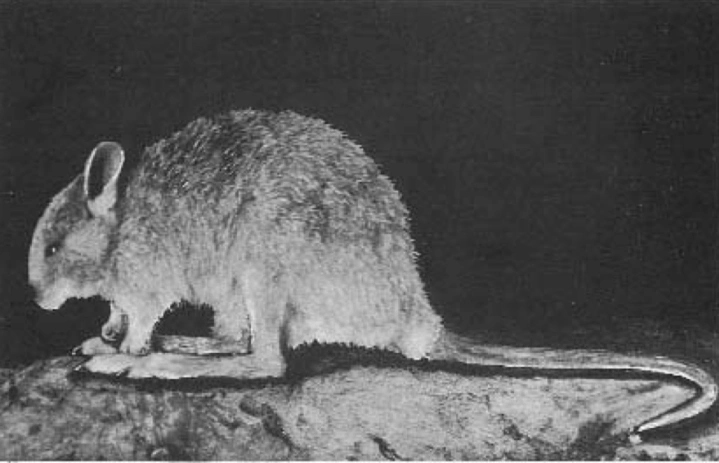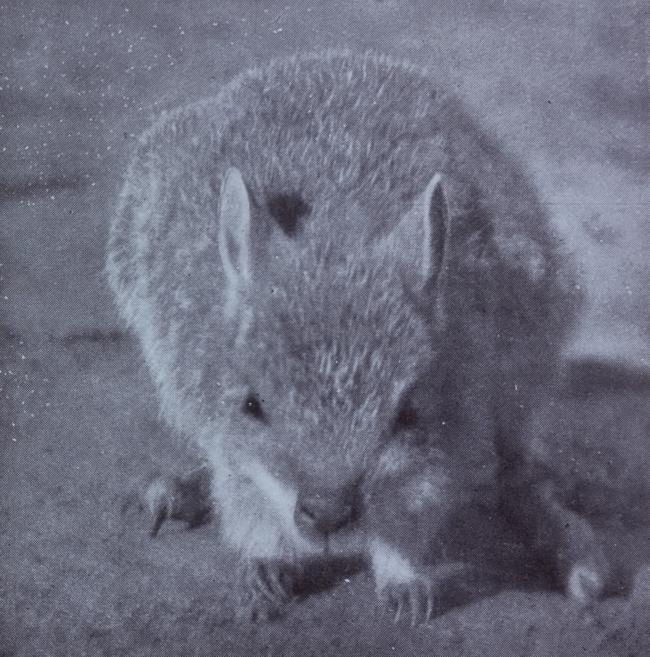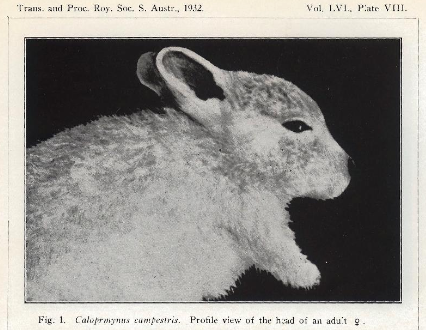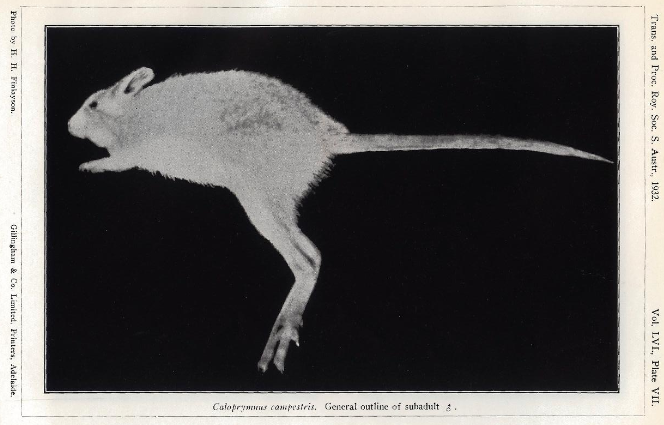Caloprymnus campestris (Gould, 1843:81)
Desert rat-kangaroo, Desert rat kangaroo, Desert bettong, Buff-nosed rat-kangaroo, Plains rat-kangaroo, Plain rat-kangaroo, Plain-loving jerboa kangaroo; ulakanda, oolacunta (Yalliyanda, Wonkonguroo); coorgee, koorjee (Yowrorka); wirtiree (Dieri); ngudlukanta (Wangkangurru)
Taxonomy & Nomenclature
Synonym/s: Bettongia campestris Gould, 1843:81 (basionym); Hypsiprymnus campestris (Gould, 1843:81)
Conservation Status
Extinct (WCMC, 1992:213; Burbidge, 2024)
Last record: 1935 (WCMC, 1992:213; Anonymous, 1994; Robinson et al., 2023:299); 1950s (?) (Johnson, 2006:169)
IUCN status: Extinct
Early European specimens (1841)
This species was first recorded in 1841 when two or three specimens were caught and sent to John Gould in London by George Grey, and these provided the basis for Gould's description of the species (Gould, 1843). No further specimens were collected during the century and the species was considered potentially extinct in the early 1900's.
A second 19th century population near Birdsville?
"Two of the most interesting, and previously uncited, references to fauna are from Hodgkinson’s journal along the Mulligan River in far western Queensland in 1876. North-west of Birdsville, he observed that ‘The kangaroo-rats here build nests three feet high against the trunks of giddia or other trees’ (7 August 1876). Based on the description of the nests, this observation probably refers to the now-extinct Caloprymnus campestris, and is a significant extension of its known former range (Finlayson 1932; Strahan 2004)."
(Silcock, 2014:35)
A third 19th century population on the Great Australian Bight?
Tate (1879:124) reports the species as being the commonest encountered on the Bunda Plateau of the Great Australian Bight, however this record is doubtful (Finlayson, 1932a:150) and no associated specimen is known to confirm the identity which likely refers to either B. lesueuri or B. penicillata (Finlayson, 1932a:150). Though interestingly, the local name given for the species (weelba) by Tate has been reported elsewhere to be one of two names (along with wirlpa) that is used by Aboriginal people of southern South Australia and adjacent Western Australia for an unidentified macropod-like species (Tunbridge, 1991:59). John Calaby suggests that this unidentified species might refer to an undescribed species known only from subfossils (Tunbridge, 1991:59). This latter species was subsequently described as Bettongia pusilla (McNamara, 1997). Whether or not the "'wirlpa', 'weelba' etc." (Tunbridge, 1991:59) refers to Caloprymnus or to Bettongia pusillus may never be known, though it seems likely that a third, now-extinct species did occur on the Great Australian Bight alongside B. lesueuri and B. penicillata.
Unofficial rediscovery (1902-1905)
Recently, it has come to light that a specimen was collected by Henry James Hillier at Lake Killalpaninna, South Australia, between 1902 and 1905 (Vernes et al., 2019).
Official rediscovery (1931)
It wasn't until September 1931, when Mr. Lou Reese, owner of Appamunna Station, sent Hedley Herbert Finlayson, Curator of Mammals at the South Australian Museum, the skin and skull of an individual in (Finlayson, 1932a,b) that the species was finally rediscovered. But by 1935 the species had disappeared again, and there have been no confirmed sightings or specimens since that date.
Of all recently extinct Australian species this is one of the best candidates for rediscovery. Since it occupied such a remote habitat, and was seemingly capable of great feats of both endurance and agility.
Unconfirmed reports, in chronological order:
1. "Another stockman remembers finally capturing a desert rat-kangaroo with dogs after several failed attempts in which his dogs “wore out the soles of their feet” chasing the animals (1954; from Carr and Robinson 1997)" (source)
2. Sightings have been made in 1956-7 and 1974-5, both following periods of rain (Carr & Robinson, 1997).
3. Fresh remains of C. campestris were apparently found in the 1980's (Lavery, 1985:46-48).*
4. Reports have also been collected up until 1988 (Carr & Robinson, 1997) from Clifton Hills Station, South Australia, where a bettong-like animal was said to have some material, presumably for nesting, in its tail, which is C. campestris behaviour.
5. Reports of the species darting out from spinifex grass clumps when disturbed by stockmen during the 1990's (Lavery & Kirkpatrick, 1997). One of these sightings may be the same as one in August 1993 as mentioned by (Robinson et al., 2023:299).
6. "And finally, a traveller camped in the region observed “We frightened a little kangaroo from a clump of saltbush, and it tore off … this tiny kangaroo quickly sped away like no other [I’d] ever seen before ” (1994; pers. comm. 2018)." (source)
7. Night time in May 2011 at Peake Station (Oodnadatta Track) in South Australia (Robinson & Forrest, 2012); "Tiana Forrest remembers seeing an animal that “moved very quickly … [It had] a rounded body … the tail was bare in that it had no long hair or tufts ”. But she only gathered a “freeze frame snapshot ” in her mind, because the animal “shot off so quickly ” (2011; from Robinson and Forrest, 2012)." (source)
8. One or more unconfirmed reports from 2013 (Vernes et al., 2021b; fide Westerman et al., 2021)
* Although this publication is cited by several authors, it is in fact incorrect, as an examination of it shows no mention of any recently dead individuals. The actual source for these claims is therefore unknown to me.
Distribution & Habitat
Queensland (historically), South Australia (historically) & Western Australia (prehistorically), Australia
Type locality: South Australia (Calaby & Richardson, 1988:56)
"Skeletal remains reported from the surface in Webb's Cave, on Mundrabilla Station, to the east of Albany, provide the first record from Western Australia, indicating a much wider range prior to the introduction of foreign mammals."
(Troughton, 1957:166; but see Lundelius, 1963)
Anatomy & Morphology
Body mass: 900gm (Johnson, 2006:169).
Biology & Ecology
"Ecology: temperate, sand plain desert, stony desert, terrestrial, nocturnal, omnivore; nest builder."
(Calaby & Richardson, 1988:56)
Hypodigm
Holotype: BMNH 1846.4.4.44 (skull) / BMNH 43.8.12.11 (skin) (adult male) (Calaby & Richardson, 1988:56)
Paratypes: 2 x immature specimens skin & skull in BMNH (Calaby & Richardson, 1988:56)
Other specimens:
MCZ 37651 (female; skin and skull)
WAM 2655 (donated in 1945; Kitchener & Vicker, 1981:50)
AM M21674 (skin; Vernes et al., 2019)
MV C 6788.2 (female, 70% ethanol) (source)
MV C 7727.1 (source)
SAM M3256 (Beck et al., 2022:SM20)
SAM M3257 (Beck et al., 2022:SM20; Mitchell et al., 2025a)
BMNH 1846.4.4.45 (Beck et al., 2022:SM20)
BMNH 1846.4.4.46 (Beck et al., 2022:SM20)
Media
At least three photos of living Desert rat-kangaroo's were taken by Hedley Herbert Finlayson in 1931, as well as at least one photo of a recently dead animal (i.e. fourth photo).

Source: https://experiment.com/u/Lw33fA; also published in (Johnson, 2006:2).

Above: "front view of adult ♀" (with blacked out background) (Finlayson, 1932a:pl. 8). This copy with background intact. Source: https://experiment.com/u/qitkgA

Source: Finlayson, 1932:a:pl 8. Copy with background intact can be seen here and probably published in (Finlayson, 1935).

Source: Finlayson, 1932:a:pl 7
Habitat photos
A photo of the Oolacunta Plain looking south-east can be seen here. Two photos of habitat can be seen in (Finlayson, 1932a). The 'Cooncherie Flats' can be seen here.
References
Original scientific description:
Gould, John. (1843). Mr. Gould then called attention to a new species of Kangaroo-rat. Proceedings of the Zoological Society of London 1843: 81.
Other references:
Anonymous. (1964). A preliminary list of rare mammals including those believed to be rare but concerning which detailed information is still lacking. IUCN Bulletin 11(Special Supplement): 4 pp.
Anonymous. (1994). Fauna reintroductions in the Australian arid zone: recent update. Wanted Alive 4: 3-4.
Archer, Michael. (1972). Nullarbor, 1969. The Western Caver 12(1): 17-24.
Archer, Michael. (1974). New information about the Quaternary distribution of the Thylacine (Marsupialia: Thylacinidae) in Australia. Journal of the Royal Society of Western Australia 57(2): 43-50.
Australasian Mammal Assessment Workshop. (2008). Caloprymnus campestris. In: IUCN 2011. IUCN Red List of Threatened Species. Version 2011.2. (http://www.iucnredlist.org). Downloaded on 01 May 2012.
Beck, Robin M. D., Voss, Robert S. and Jansa, Sharon A. (2022). Craniodental morphology and phylogeny of marsupials. Bulletin of the American Museum of Natural History 457: 350 pp., 55 figures, 13 tables. [Supplemental Material]
Breeden, K. (1964). Life on the gibber plains. Walkabout 30(4): 14-16. [mentions Caloprymnus campestris?]
Burbidge, Andrew A. (2024). Australian terrestrial mammals: how many modern extinctions? Australian Mammalogy. https://doi.org/10.1071/AM23037
Burbidge, Andrew A. and Jenkins, R. W. G. (1984). Endangered Vertebrates of Australia and Its Island Territories. Canberra, ACT: Australian National Parks and Wildlife Service. 34 pp.
Calaby, J. (1971). The current status of Australian Macropodidae. Australian Zoology 16: 17-29.
Calaby, J. H. and Richardson, B. J. (1988). Potoroidae, pp. 53-59. In: Walton, D. W. (ed.). Zoological Catalogue of Australia. Volume 5. Mammalia. Canberra: Australian Government Publishing Service. x + 273 pp. [p. 56]
Carr, Steve G. and Robinson, Anthony C. (1997). The present status and distribution of the Desert Rat-kangaroo Caloprymnus campestris (Marsupialia: Potoroidae). South Australian Naturalist 72: 4-27.
Collins, L. R. (1973). Monotremes and marsupials. A reference for zoological institutions. Washington D.C.: Smithsonian Institute Press. v + 323 pp.
Department of Sustainability, Environment, Water, Population and Communities (2011). Caloprymnus campestris in Species Profile and Threats Database, Department of Sustainability, Environment, Water, Population and Communities, Canberra. Available from: http://www.environment.gov.au/sprat . Accessed Sat, 15 Jan 2011 15:24:57 +1100.
Dickman, C.R. 1996. Overview of the impacts of feral cats on Australian native fauna. Australian Nature Conservation Agency, Canberra.
Dixon, Joan M. (1988). Notes on the diet of three mammals presumed to be extinct: the Pig-footed Bandicoot, the Lesser Bilby and the Desert Rat Kangaroo. Victorian Naturalist 105: 208-211.
Finlayson, Hedley Herbert. (1932a). Caloprymnus campestris. Its Recurrence and Characters. Transactions of the Royal Society of South Australia 56: 148-167.
Finlayson, Hedley Herbert. (1932b). Rediscovery of Caloprymnus campestris (Marsupialia). Nature 129: 871. [Abstract]
Finlayson, Hedley Herbert. (1935). The Red Centre: Man and beast in the heart of Australia. Sydney. 146 pp.
Finlayson, Hedley Herbert. (1958). On Central Australian mammals (with notice of related species from adjacent tracts). Part III. The Potoroinae. Records of the South Australian Museum 13: 235-302.
Finlayson, Hedley Herbert. (1961). On central Australian mammals. Part IV. The distribution and status of central Australian species. Records of the South Australian Museum 14: 141-191.
Fisher, Clem T. (1985). From John Gilbert to John Gould. Australian Zoologist 22(1): 5-14. https://doi.org/10.7882/AZ.1985.002
Fisher, Diana O. (2011). Trajectories from extinction: where are missing mammals rediscovered? Global Ecology & Biogeography 20: 415-425. https://doi.org/10.1111/j.1466-8238.2010.00624.x [Appendix S1]
Flannery, Timothy F. (1989). Phylogeny of the Macropodoidea; a study in convergence, pp. 1-46. In: Grigg, G. C., Jarman, P. and Hume, I. D. (eds.). Kangaroos, Wallabies and Rat-kangaroos. Chipping Norton, NSW: Surrey Beatty & Sons.
Flannery, Timothy F. (1990). Australia's Vanishing Mammals: Endangered and Extinct Native Species. Sydney: RD Press. 192 pp.
Flannery, Timothy F. and Archer, Michael. (1987). Bettongia moyesi, a new and plesiomorphic kangaroo (Marsupialia: Potoroidae) from Miocene sediments of northwestern Queensland, pp. 759-767. In: Archer, Michael (ed.). Possums and Opossums: Studies in Evolution. Sydney: Surrey Beatty & Sons and The Royal Zoological Society of New South Wales.
Flannery, T. and Schouten, P. 2001. A gap in nature: discovering the world’s extinct animals. Text Publishing, Melbourne.
Frith, H. J. (1979). Wildlife Conservation, revised edition. Angus & Robertson. xiv + 416 pp. [p. 35, p. 302 (table), p. 318-319 (species account)]
Goodwin, Harry A. and Goodwin, J. M. (1973). List of mammals which have become extinct or are possibly extinct since 1600. Int. Union Conserv. Nat. Occas. Pap. 8: 1-20.
Harper, F. (1945). Extinct and vanishing mammals of the Old World. American Committee for International Wild Life Protection, New York.
Hodgkinson, W. O. (1877). North-West Explorations, Parliamentary Papers (24 January), held by State Library of Queensland, Brisbane, pp. 203-226.
Hoser, Raymond T. (1991). Endangered Animals of Australia. Mosman, NSW: Pierson & Co. 240 pp. [pp. 204]
Iredale, Tom and Troughton, Ellis Le Geyt. (1934). A check-list of the mammals recorded from Australia. Mem. Aust. Mus. 6: i-xii, 1-122.
Jackson, Stephen and Groves, Colin. (2015). Taxonomy of Australian Mammals. Clayton South, Melbourne: CSIRO Publishing. 529 pp. [p. 137]
Janis, Christine M. (1990). Correlation of cranial and dental variables with dietary preferences in mammals: a comparison of macropodoids and ungulates. Mem. Qd. Mus. 28(1): 349-366.
Jenkins, M. and Thornback, J. 1982. The IUCN Mammal Red Data Book Part 1. IUCN Gland, Suiz. pgs. 33-34.
Johnson, Chris N. (2006). Australia's Mammal Extinctions: A 50 000 Year History. Port Melbourne, Victoria: Cambridge University Press. x + 278 pp. [p. 1-2, pl. 21, p. 169]
Johnston, T. Harvey. (1943). Aboriginal Names and Utilization of the Fauna in the Eyrean Region. TRSSA 67(2): 244-311.
Joslin, Paul and Maryanka, Daphne. (1968). Endangered Mammals of the World: Report on Status and Action Treatment. IUCN Publications, New Series, Supplementary Paper No. 13: 34 pp.
Kinnear, J., Sumner, N.R. and Onus, M.L. 2002. The red fox in Australia—an exotic predator turned biocontrol agent. Biological Conservation 108: 335-359.
Kitchener, D. J. and Vicker, E. (1981). Catalogue of Modern Mammals in the Western Australian Museum 1895 to 1981. Perth: Western Australian Museum. 184 pp.
Krefft, Gerard. (1871). The Mammals of Australia, Illustrated by Harriett Scott and Helena Forde for the Council of Education ; With a Short Account of All the Species Hitherto Described. Sydney: Thomas Richards, Government Printer.
Lavery, Hugh J. (ed.). (1985). The Kangaroo Keepers. St. Lucia, Queensland: Queensland University Press. 211 pp.
Lavery, Hugh J. and Kirkpatrick, T. H. (1997). Field management of the bilby Macrotis lagotis in an area of south-western Queensland. Biological Conservation 79: 271.
Lucas, Arthur Henry Shakespeare and Le Souëf, William Henry Dudley. (1909). The Animals of Australia: Mammals, Reptiles and Amphibians. Melbourne: Whitcombe and Tombs.
Lundelius, Ernest L. Jr. (1957). Additions to knowledge of the ranges of Western Australian mammals. The Western Australian Naturalist 5(7): 173-182.
Lundelius, Ernest L. Jr. (1963). Vertebrate remains from the Nullarbor Caves, Western Australia. Journal of the Royal Society of Western Australia 46: 75-80.
Lundelius, Ernest L. Jr. and Turnbull, William D. (1984). The mammalian fauna of Madura Cave, Western Australia. Part VI: Macropodidae: Potorinae. Fieldiana, Geology, new series no. 14. Field Museum of Natural History, Chicago.
Lundelius, Ernest L. Jr. and Turnbull, W. D. (1989). The mammalian fauna of Madura Cave, Western Australia. Part VII: Macropodidae: Sthenurinae, Macropodinae, with a review of the marsupial portion of the fauna. Fieldiana, Geology, new series 17: 1-71.
Maxwell, S., A.A. Burbidge & K. Morris (1996). The 1996 Action Plan for Australian Marsupials and Monotremes. [Online]. Wildlife Australia, Environment Australia. Available from: http://www.environment.gov.au/biodiversity/threatened/publications/action/
McNamara, J. C. (1997). Some smaller macropod fossils of South Australia. Proceedings of the Linnean Society of New South Wales 117: 97-106. [correction of identification by Lundelius & Turnbull, 1984]
Medlin, G. C. (1993). A Field Guide to Chambers Gorge, Flinders Ranges. Adelaide: South Australian Museum.
Mitchell, D. Rex, Wroe, Stephen, Martin, Meg and Weisbecker, Vera. (2025a). Testing hypotheses of skull function with comparative finite element analysis: three methods reveal contrasting results. Journal of Experimental Biology 228(4): JEB249747. https://doi.org/10.1242/jeb.249747
Mitchell, D. Rex, Vernes, Karl and Weisbecker, Vera. (26 February, 2025b). Presumed extinct, this desert rat-kangaroo may still be alive in hiding. New analysis reveals its delicate diet. The Conversation (blog). Available at: https://theconversation.com/presumed-extinct-this-desert-rat-kangaroo-may-still-be-alive-in-hiding-new-analysis-reveals-its-delicate-diet-250283 [Accessed 28 February 2025]
Ogilby, J. Douglas. (1892). Catalogue of Australian Mammals, with Introductory Notes on General Mammalogy. Australian Museum, Sydney: Catalogue No. 16: viii + 142 pp.
Philpott, C. M. and Smyth, D. R. (1967). A contribution to our knowledge of some rare mammals from inland Australia. Transactions of The Royal Society of South Australia 91: 115-134. [failed to find this species during 24 weeks of field work in "northern South Australia and adjoining areas"]
Ride, W. D. L. (1970). A Guide to the Native Mammals of Australia. Melbourne: Oxford University Press.
Robertson, G. (1982). Bettongs Genera Bettongia Aepyprymnus Caloprymnus. Pp. 9-14 in Parks and Wildlife. Kangaroos. (undated).
Robinson, Anthony C. and Forrest, Tiana. (2012). A possible sighting of the Desert Rat-kangaroo or Oolacunta (Caloprymnus campestris) on the Peake Station, South Australia. The South Australian Naturalist 86(2): 63-75. [Abstract]
Robinson, Anthony C., Smith, M. J. and Johnson, P. M. (2023). Desert Rat-kangaroo, Caloprymnus campestris, pp. 298-299. In: Baker, Andrew M. and Gynther, Ian C. (eds.). Strahan’s Mammals of Australia (4th ed.). Wahroonga, NSW: Reed New Holland Publishers. 848 pp.
Scott, Peter (ed.). (1965). Preliminary List of Rare Mammals and Birds, pp. 155-237. In: The Launching of a New Ark. First Report of the President and Trustees of the World Wildlife Fund. An International Foundation for saving the world's wildlife and wild places 1961-1964. London: Collins.
Silcock, Jennifer Lesley. (2014). Degraded or just dusty?: 150 years of ecological change in inland eastern Australia. Unpublished thesis.
Smith, M. J. (1983). Desert rat-kangaroo, Caloprymnus campestris, pp. 192. In: Strahan, Ronald. (ed.) The Australian Museum Complete book of Australian mammals. Sydney: Angus and Robertson.
Smith, M. J. (1995). Desert rat-kangaroo. Caloprymnus campestris, pp. 296-297. In: Strahan, Ronald. (ed.). Mammals of Australia. Sydney: Australian Museum/Reed New Holland.
Smith, M. J. and Johnson, P. M. (2008). Desert Rat-kangaroo, Caloprymnus campestris, pp. 295-296. In: S. Van Dyck and Strahan, Ronald (eds), The mammals of Australia. Third Edition. Reed New Holland, Sydney, Australia.
South Australian Museum (2007). Desert Rat-kangaroo, Caloprymnus campestris. [Online]. Available from: http://www.samuseum.sa.gov.au/extinctions/desrat.htm
Strahan, Ronald (ed.). (2004). The Mammals of Australia. Sydney: Reed New Holland.
Tate, Ralph. (1879). The natural history of the company around the head of the Great Australian Bight. Transactions of the Royal Society of South Australia 2: 94-128. [p. 124]
Tedford, Richard H. (1967). The fossil Macropodidae from Lake Menindee, New South Wales. Univ. Calif. Publ. Geol. Sci. 64: 1-156.
Thomas, Oldfield. (1888). Catalogue of the Marsupialia and Monotremata in the collection of the British Museum (Natural History). London: British Museum (Natural History). xiii + 401 pp, 33 pls. [erection of the genus Caloprymnus]
Thornback, Jane and Jenkins, Martin (compilers). (1982). The IUCN Mammal Red Data Book. Part 1: Threatened Mammalian Taxa of the Americas and the Australasian Zoogeographic Region (Excluding Cetacea). Gland, Switzerland: IUCN. 516 pp.
Troughton, Ellis Le Geyt. (1943). The kangaroo family. Rat Kangaroos, 2. The Australian Museum Magazine 8(6): 204-207.
Troughton, Ellis Le Geyt. (1957). Furred Animals of Australia, 6th edition. Sydney: Angus & Robertson.
Tunbridge, Dorothy. (1991). The Story of the Flinders Ranges Mammals. Kenthurst: Kangaroo Press. 96 pp. [p. 15, p. 19, p. 58-59 (species account)]
Turvey, Samuel T. (2009). Holocene mammal extinctions, pp. 41-61. In: Turvey, Samuel T. (ed.). Holocene Extinctions. Oxford, UK & New York, USA: Oxford University Press. xii + 352 pp.
Turvey, Samuel T. and Fritz, Susanne A. (2011). The ghosts of mammals past: biological and geographical patterns of global mammalian extinction across the Holocene. Philosophical Transactions of the Royal Society B 366(1577): 2564-2576. https://doi.org/10.1098/rstb.2011.0020 [Supplementary Information]
Vernes, Karl, Elliott, Todd F. and Jackson, Stephen M. (2021a). 150 years of mammal extinction and invasion at Koonchera Dune in the Lake Eyre Basin of South Australia. Biological Invasions 23: 593-610. https://doi.org/10.1007/s10530-020-02387-2 [Abstract]
Vernes, Karl, Ingleby, Sandy and Eldridge, Mark. (2019). An overlooked, early record of the desert rat-kangaroo (Caloprymnus campestris) from Lake Killalpaninna, South Australia. Australian Mammalogy 42(2): 223-225. [Abstract]
Vernes, Karl, Jackson, Stephen M., Elliott, Todd, Elliott, Kelsey and Carr, Steven. (2021b). A search for the desert rat-kangaroo or ngudlukanta (Caloprymnus campestris) in north-eastern South Australia. Australian Mammalogy 44(2): 225-235. https://doi.org/10.1071/AM21022
Vernes, Karl, Jackson, Stephen M., Elliott, Todd, Elliott, Kelsey and Carr, Steven G., Ingleby, Sandy and Eldridge, Mark D. B. (2021c). What do we know about the status and distribution of the ngudlukanta (Caloprymnus campestris)?, p. 85. In: Conference Programme & Abstract List for the 67th Annual Scientific Meeting of the Australian Mammal Society Virtual, 28 September to 1 October, Perth, WA, 2021.
Waterhouse, George Robert. (1845). A Natural History of the Mammalia. Volume 1, Containing the Order Marsupiata or Pouched Animals. London: Hippolyte Baillière. 553 pp + 20 pls.
WCMC (World Conservation Monitoring Centre). (1992). Global Biodiversity: Status of the Earth's living resources. London: Chapman & Hall. xx + 594 pp.
Westerman, Michael, Loke, Stella and Springer, M. S. (2004). Molecular phylogenetic relationships of two extinct potoroid marsupials, Potorous platyops and Caloprymnus campestris (Potoroinae: Marsupialia). Molecular Phylogenetics and Evolution 31(2): 476-485. [Abstract]
Westerman, Michael, Loke, Stella, Tan, Mun Hua and Kear, Benjamin. (2021). Mitogenome of the Extinct Desert ‘Rat-Kangaroo’ Times the Adaptation to Aridity in Macropodoids. Research Square [preprint]. https://doi.org/10.21203/rs.3.rs-1065679/v1
Westerman, Michael, Loke, Stella, Tan, Mun Hua and Kear, Benjamin. (2022). Mitogenome of the extinct Desert ‘rat-kangaroo’ times the adaptation to aridity in macropodoids. Scientific Reports 12: 5829. https://doi.org/10.1038/s41598-022-09568-0
Woinarski, John C. Z., Braby, M. F., Burbidge, A. A., Coates, D., Garnett, S. T., Fensham, R. J., Legge, S. M., McKenzie, N. L., Silcock, J L. and Murphy, B. P. (2019). Reading the black book: The number, timing, distribution and causes of listed extinctions in Australia. Biological Conservation 239: 108261. https://doi.org/10.1016/j.biocon.2019.108261
Woinarski, J. & Burbidge, A. A. (2016). Caloprymnus campestris. The IUCN Red List of Threatened Species 2016: e.T3626A21961545. https://dx.doi.org/10.2305/IUCN.UK.2016-2.RLTS.T3626A21961545.en. Downloaded on 26 August 2019.
Wood Jones, Frederic. (1924). The Mammals of South Australia. Part II. The Bandicoots and the Herbivorous Marsupials (The syndactylous Didelphia). Adelaide: Government Printer. 2: 132-270. [8 August 1924] [p. 205 (generic key), p. 215-216 (species account)]
http://www.cites.org/common/cop/16/prop/raw/CoP16-Prop-AU-Caloprymnus_campestris.pdf
https://archive.org/stream/MemoirsQueensla28Quee#page/364/mode/2up
https://cites.org/sites/default/files/common/com/ac/26/E26-20i.pdf
https://extinctanimals.proboards.com/thread/6268/caloprymnus-campestris-desert-rat-kangaroo
